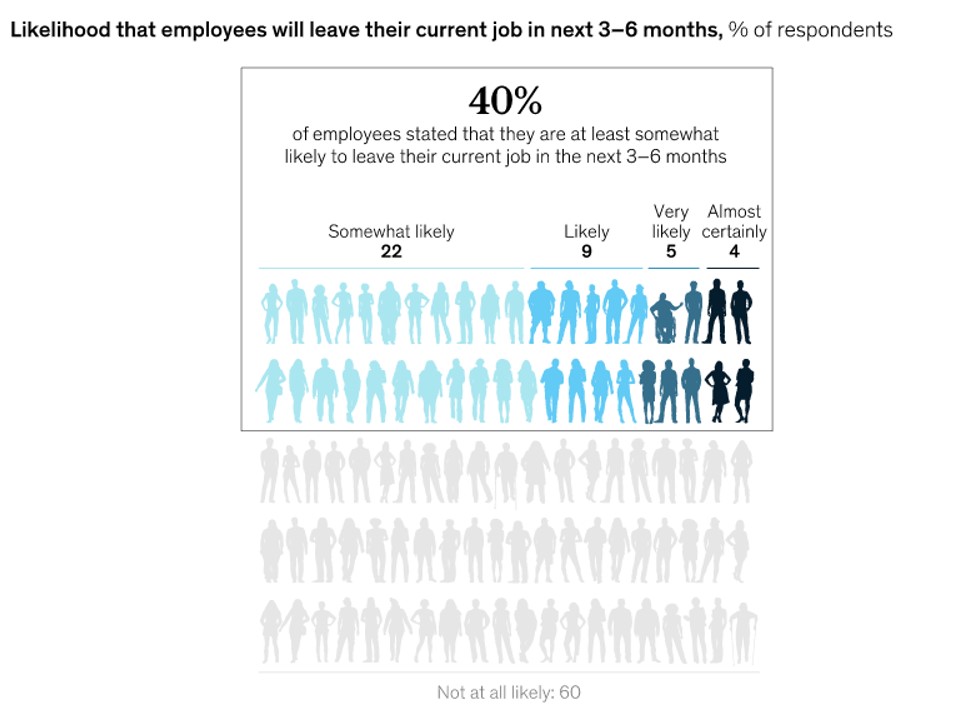Employee Loyalty is at Breaking Point: Why Employees Are Resigning Post-COVID

The ‘Great Resignation’ are words likely ringing in the ears of employers everywhere. It pertains to the disproportionate rise in staff attrition over recent months, which made waves first in the US, with a reported 19 million US workers and counting having quit their jobs since April 2021,[1] and is now set to go global.
McKinsey & Company surveyed employees from Australia, Canada, Singapore, the United Kingdom, and the United States, and found that 40% are ‘somewhat likely’ to quit in the next three to six months (December 2021 to March 2022), and 18% said their intentions to quit range from ‘likely’ to ‘almost certain’.

What’s more troubling is that, according to the same survey, 36% of respondents who had quit their jobs between March and September 2021 had done so without a job lined up. This paints a revealing picture of employee loyalty – or the lack thereof.
Why is employee loyalty vital to every workplace?
Employee loyalty is the beating heart of a successful organisation, and loyal employees will invest more of themselves into their work and into the organisation. Therefore, when loyalty in the workplace wanes it undoubtedly poses huge problems for employers.
Below are some advantages of employee loyalty:
It increases productivity
When employees trust in their employer and are aligned with the organisation’s purpose and vision, they are engaged, they work harder, have better ideas, and want to learn.
It strengthens the employer brand
When employees love where they work, it’s plain to see from the outside. Such enthusiasm enhances the employer brand, which in turn attracts top quality candidates.
It generates higher ROI
When employees are happy, they yield healthy profits. A positive employee experience (EX) – that is, an employee’s journey with a company – directly impacts the customer experience (CX), leading to greater returns.
Why are more and more employees resigning post-COVID?
The reason why the ‘Great Resignation’ is being felt around the world can be attributed to multiple factors. Possible reasons why employees are resigning post-COVID-19 relate to:1
- Compensation
- Flexible / remote working opportunities
- Work-life balance
- Unmanageable workloads
- Poor health
- Career advancement
- Felt undervalued or lacking a sense of belonging
If employers are out of touch with the above, it can cause disengagement and, eventually, disloyalty. It’s important to note, also, that departing employees put more pressure on those that remain, as they must pick up the slack. Adding further insult to injury is the realisation for existing employees that the market is offering higher salaries to attract new candidates. According to the Hays Recruitment Salary Guide, 67% of Australian and New Zealand employers said they would increase salaries to meet candidate demands.[2] With compensation being a pain point for many, loyal employees may become disloyal employees very quickly.
It’s clear that employees are on the precipice. They have been tried and tested – both professionally and personally – for the best part of two years, and one small misstep from their employer may be the last push they need to jump ship.
How to spot employees who are about to resign
When employees have one foot out of the door, there are some warning signs to look out for. These may include:
- They become disengaged
- They show little interest in their work and in the organisation
- The quality of their work suffers
- Their attitude changes negatively
- They isolate themselves
- They take more days off
- They become less of a team player
Employees that are exhibiting at least a few of the above warning signs can be considered a flight risk, and measures must be taken by their manager / HR to retain them.
How to increase employee loyalty and reduce resignations
ELMO’s Employee Sentiment Index identified employees’ priorities in 2021. In Australia and New Zealand, the top three overall priorities of employees in 2021 are:
- Remuneration and bonus payments / incentives
- Stability of an organisation
- Flexible / remote working
Robert Half[3] found that 64% of Australian companies had added new benefits because of the COVID-19 pandemic, including wellness programs (59%), mental health resources (49%), and additional paid family leave (46%).
It’s critical that employers are aware of these key ingredients when it comes to retaining top talent. However, despite best efforts, these alone won’t make a departing employee turn on their heel and stay loyal to an organisation. So, what else can employers do to increase engagement and cultivate loyalty long-term? Below are three tips.
Create a culture of recognition and feedback
Fostering a culture of recognition and feedback is a sign of organisational health, where morale is high, and employees are empowered and productive. After a tumultuous 18 months, this is integral.
Recognition is about recognising a job well done or acknowledging a particular behaviour – a figurative or literal pat on the back. It can be as simple as a manager saying “thanks” for a job well done – this can have a tremendous impact on motivation. Note: for a recognition program to be effective it should happen in real-time.
Furthermore, it’s likely that employees have a lot to say about how they want to work. Measuring employee engagement is critical, and employers that don’t listen can cause disengagement and frustration. Therefore, conducting regular pulse surveys – and taking action on the feedback obtained – will empower employees and increase the feeling of belonging. Collect, manage, analyse, and compare survey data with ELMO Survey.
Improve performance management processes
As mentioned earlier, feeling undervalued and having unmanageable workloads can sow seeds of doubt in employees – both of which point to the need for better performance management processes.
Employers can build trust and increase engagement by improving how they evaluate and assess employees. This may include scheduling in more regular manager-employee check-ins, conducting project-based reviews, and being more empathetic towards employees’ personal lives as well as their wants – all of which can be made easier with ELMO Performance Management. One way to recognise high performers in a holistic way is to implement a total rewards strategy.
Build a positive workplace culture
The culture of an organisation can be described as its ‘personality’ – the way employees interact with each other and their work, and the atmosphere that is perpetuated.
According to research by Deloitte, 94% of executives and 88% of employees believe a distinct culture is important to a business’s success,[4] so striving for a positive culture should be a big-ticket item on the company agenda.
Below are some ways employers can cultivate a healthy workplace culture:
- Ensure communication from senior leaders is open and transparent
- Recognise and reward top performers – and give support to those who are underperforming
- Offer learning and development opportunities
- Survey employees regularly to gauge worker sentiment
With a positive and strong workplace culture at its foundation, an organisation can earn the loyalty of employees which will improve retention efforts.
The ‘Great Resignation’ may be a daunting prospect, but if employers are smart and listen to their employees, they can weather the storm. And remember, not all staff turnover is bad – in small amounts it can be healthy and can make space for new employees who can breathe life into old processes.
ELMO Software is a cloud-based solution that helps thousands of organisations across Australia, New Zealand and the United Kingdom to effectively manage their people, process and pay. ELMO solutions span the entire employee lifecycle from ‘hire to retire’. They can be used together or stand-alone, and are configurable according to an organisation’s unique processes and workflows. Automate and streamline your operations to reduce costs, increase efficiency and bolster productivity. For further information, contact us.
[1] “‘Great Attrition’ or ‘Great Attraction’? The choice is yours”, McKinsey & Company, September 2021
[2] Hays Salary Guide FY21/FY22
[3] Salary Guide 2021, Robert Half
[4] “Core beliefs and culture: Chairman’s survey findings”, Deloitte, 2018
 HR Core
HR Core 









